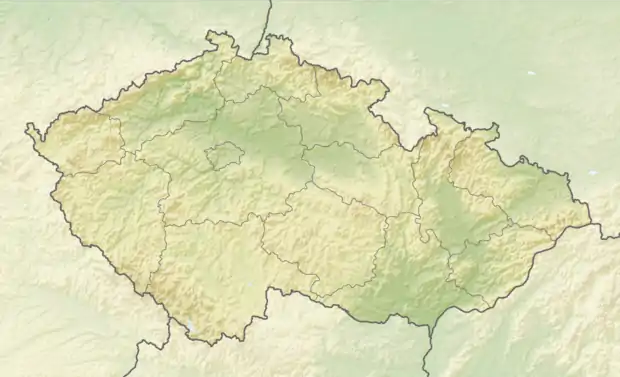Mohelnice (Šumperk District)
Mohelnice (Czech pronunciation: [ˈmoɦɛlɲɪtsɛ]; German: Müglitz) is a town located in the Šumperk District in the Olomouc Region of the Czech Republic. It has about 9,200 inhabitants.
Mohelnice | |
|---|---|
Town | |
 Freedom Square | |
 Flag  Coat of arms | |
 Mohelnice Location in the Czech Republic | |
| Coordinates: 49°46′39″N 16°55′24″E | |
| Country | |
| Region | Olomouc |
| District | Šumperk |
| First mentioned | 1131 |
| Government | |
| • Mayor | Pavel Kuba |
| Area | |
| • Total | 46.21 km2 (17.84 sq mi) |
| Elevation | 267 m (876 ft) |
| Population (2020-01-01[1]) | |
| • Total | 9,234 |
| • Density | 200/km2 (520/sq mi) |
| Time zone | UTC+1 (CET) |
| • Summer (DST) | UTC+2 (CEST) |
| Postal code | 789 85 |
| Website | www |
Mohelnice is the centre of the microregion Mohelnicko.[2]
History
The region has been inhabited since the Stone Age. Mohelnice is mentioned in a written document from 1131 (as a village owned by the bishopric of Olomouc). Castle Mírov is mentioned in 1266 and was completed some time after 1320. In 1273 Mohelnice was granted town status. In 1307 and 1312 the town was devastated by plague and in 1424 it was conquered by the Hussites (700 people died). During the first half of the 16th century the town was rebuilt. The Thirty Years' War devastated Mohelnice – in 1623 it was plundered by Swedish troops and over 30% of the inhabitants died either from enemy attacks or plague which returned in 1642, 1643, 1644 and 1647. In 1662 half of the town was destroyed by fire. 1685 saw the notorious witchcraft trials during which a local priest was burned at the stake. The town's textile industry began operating in 1713, and in 1714 the town suffered another plague. There was another significant fire in 1739. During the Silesian Wars the town was plundered several times.
In 1772 Mohelnice had 1867 inhabitants, barely half of the number it had in the 16th century but the population began to recover. In 1792 it was 3887. There were cholera epidemics in 1832, 1849, 1851 and 1866. The town suffered from fire in 1841 and few smaller fires later. In 1863 Mohelnice built its first sanitation system.
The 19th and 20th century saw the growth of manufacturing and industry including sugar processing, engineering, electrotechnics.
In 1910 the old town walls were demolished.
The town had a German-speaking majority population who comprised around 95% of the population before World War II. In 1938 the town was occupied by Nazi Germany as part of Sudetenland. After the war all citizens over the age of 18 who had German nationality were expelled from Czechoslovakia. This caused the town to become almost deserted. Within a few months, however, the town was repopulated as immigrants arrived from other parts of Czechoslovakia.
In the second half of the 20th century the town went through major urban changes, including the narrowing of the Mírovka river and the demolition of the old houses in the northern part of the suburb. These were replaced with the large high rise apartment buildings which are part of today's town skyline.
Economy
Mohelnice is predominantly industrial with significant electrotechnical, engineering and construction industries. The town also boasts a new industrial zone.
Culture
Mohelnice is famous for the folk and country music festival Mohelnický dostavník.[3]
Sights
The remains of the 14th-century town walls can be seen and the 1540 town gate has been preserved. There is a 14th-century church dedicated to St. Thomas Becket and the St. Stanislaus Church built in 1584. The Bishop's Castle is now a museum dedicated to Mohelnice's history.
Notable people
- Antonín Brus z Mohelnice (1518–1580), Archbishop of Prague
- Martin Medek z Mohelnice (1538–1590), Archbishop of Prague
- Antal Stašek (1843–1931), writer; worked here in 1913–1914
- Edmund Reitter (1845–1920), entomologist, writer and collector
- Richard Schmitz (1885–1954), mayor of Vienna in 1934–1938
- Martin Horák (born 1980), footballer
References
- "Population of Municipalities – 1 January 2020". Czech Statistical Office. 2020-04-30.
- https://www.mohelnice.cz/region.asp
- http://www.mohelnickydostavnik.cz/
- "Main Page: Partnerské město". mohelnice.cz (in Czech). Město Mohelnice. Retrieved 2020-09-22.
External links
- Official website (in Czech)
- Mohelnice Museum (in Czech)